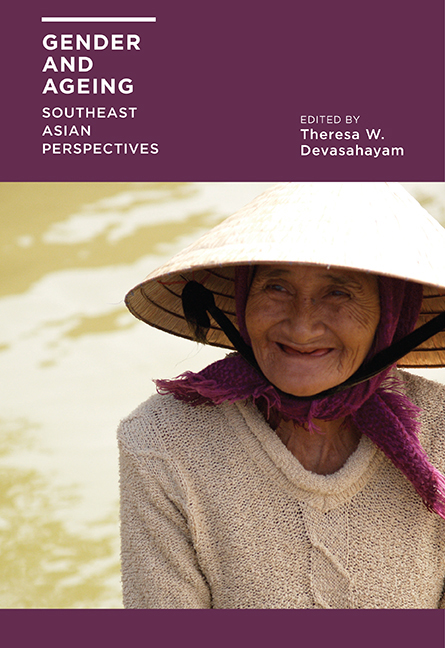Book contents
- Frontmatter
- Contents
- List of Tables and Figures
- Acknowledgments
- Contributors
- 1 Growing Old in Southeast Asia: What Do We Know about Gender?
- 2 Gender and Ageing in Thailand: A Situation Analysis of Older Women and Men
- 3 Gender and Well-being of Older Persons in Cambodia
- 4 Preparations for Old Age and Social Participation of Present and Future Older Persons in Thailand: Gender Difference
- 5 Gender and Health Status among Older Adults in Vietnam
- 6 Ageing and Gender Preferences in Rural Indonesia
- 7 Exploring the Experiences of Older Men and Women in Caregiving and Care-receiving in Sarawak, Malaysia
- 8 An “Active Ageing” Approach to Living Alone: Older Men and Women Living in Rental Flats in Singapore
- 9 Ethnic Patterns and Styles of Active Ageing among Widows and Widowers in Singapore
- 10 Employment Patterns of Older Women in Indonesia
- 11 Gender Differentials in Work and Income among Older Malaysians
- 12 Gender and Economic Well-being among Older Filipinos
- 13 Work, Retirement and the Gender Divide in the Philippines
- Index
10 - Employment Patterns of Older Women in Indonesia
Published online by Cambridge University Press: 21 October 2015
- Frontmatter
- Contents
- List of Tables and Figures
- Acknowledgments
- Contributors
- 1 Growing Old in Southeast Asia: What Do We Know about Gender?
- 2 Gender and Ageing in Thailand: A Situation Analysis of Older Women and Men
- 3 Gender and Well-being of Older Persons in Cambodia
- 4 Preparations for Old Age and Social Participation of Present and Future Older Persons in Thailand: Gender Difference
- 5 Gender and Health Status among Older Adults in Vietnam
- 6 Ageing and Gender Preferences in Rural Indonesia
- 7 Exploring the Experiences of Older Men and Women in Caregiving and Care-receiving in Sarawak, Malaysia
- 8 An “Active Ageing” Approach to Living Alone: Older Men and Women Living in Rental Flats in Singapore
- 9 Ethnic Patterns and Styles of Active Ageing among Widows and Widowers in Singapore
- 10 Employment Patterns of Older Women in Indonesia
- 11 Gender Differentials in Work and Income among Older Malaysians
- 12 Gender and Economic Well-being among Older Filipinos
- 13 Work, Retirement and the Gender Divide in the Philippines
- Index
Summary
LIFE OF OLDER PERSONS
It is a very hot day in an overly-crowded and polluted street in Jakarta. When the traffic light turns red, out of nowhere a group of people emerge and start approaching the cars and motorcycles, begging for money. This group includes some older men and women who have resorted to begging so as to make ends meet. In Singapore, another big city in Southeast Asia, older men and women do “odd jobs” such as cleaning dirty tables at hawker centres and public toilets. Is this the kind of employment older people are expected to take on in some parts of Southeast Asia?
In contrast, there are many older men and women in Indonesia who do not do “anything”. They live in beautiful houses; they travel a lot for leisure; and they have rich children to support them. One older man works for a family business run by his son; he enjoys the work, not because of the money, but because of the nature of the job and also because it keeps him occupied. He also partakes in the profit from this business. Moreover his wife enjoys her leisure; she pursues her time exercising, visiting friends, meeting her children, children-in-law, and grandchildren. A question arises regarding the kinds of activities one would expect older persons to engage in. We could also ask if an older person who engages in wage work is better off than someone who does not? In essence, what kind of life should older persons be leading?
This chapter represents a preliminary attempt to provide the first and important step at answering that question, by analysing the employment patterns of older women in Indonesia. It provides information on what the older persons, particularly older women, do within and outside the labour market. The analysis relies on a national data set collected in 2007. Therefore, readers need to be careful when generalizing the findings in this chapter beyond 2007.
- Type
- Chapter
- Information
- Gender and AgeingSoutheast Asian Perspectives, pp. 240 - 266Publisher: ISEAS–Yusof Ishak InstitutePrint publication year: 2014



